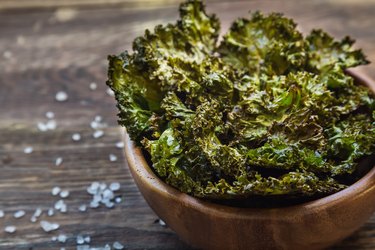
Growing up, you may have been told repeatedly that it's important to eat your greens. But were you ever told why?
Turns out, there's a long, long list of reasons leafy greens are so critical for our health, and they go far beyond the frustrating parental idiom of "because I said so."
Video of the Day
Video of the Day
"Eating leafy greens is one of the best ways to prevent disease and promote health," certified holistic nutritionist Celeste Perez tells LIVESTRONG.com.
Not only do veggies like kale, spinach and cabbage provide roughage that helps with digestion and nutrients that support heart and bone health, Perez says, but they're also full of fiber and low in calories, which make them a perfect food to support your weight-loss goals.
"The fiber found in leafy greens helps you stabilize blood sugar and manage hunger, contributing to weight loss," Tallene Hacatoryan, RD, founder of PCOS Weight Loss, tells LIVESTRONG.com.
Let's talk about fiber for a sec, because most people aren't getting enough, according to a January-February 2017 paper in the American Journal of Lifestyle Medicine. In fact, only about 5 percent of Americans get the recommended daily intake.
What's considered enough? About 25 to 38 grams each day for adults up to age 50, and 21 to 30 daily grams for those over 50, according to the 2015-2020 Dietary Guidelines for Americans.
If weight loss is your goal, simply aiming to eat 30 grams of fiber each day might help you get there, according to a February 2015 Annals of Internal Medicine study. People who did so lost weight as effectively as those following a more complicated diet.
Fortunately, upping your leafy green (and thus fiber) game doesn't require chomping through bland salads or swapping out all your favorite foods for steamed kale. There are so many ways to sneak greens into your daily diet that taste good and boost your nutrition at the same time. Here are five ideas to get you started.
1. Add Greens to Smoothies
The fruit-plus-vegetable smoothie has had plenty of time to shine in the health world, but there's a reason the fad isn't going away anytime soon. It's very easy to conceal the taste of more bitter greens with the right combo of sweet fruit and creamy nut butter or seeds.
Perez recommends adding two servings of veggies for every one serving of fruit to help keep the drink's sugar content on the lower side; plus, she says, more greens will help regulate insulin levels. For those concerned about sugar spikes, Perez suggests sticking with berries like blueberries and raspberries (also high in fiber!), which are low on the glycemic index.
If you're extra turned off by the taste of greens, Perez says a little citrus can go a long way. A squeeze of lemon or lime works because "acidity offsets bitterness," she says. You can also add an apple to do this same kind of work.
2. Defy the Recipe
Who says you can't use two cups of kale when a soup recipe calls for one? Feel free to be overzealous with vegetable ingredients, especially in recipes that are more fluid and up for interpretation, like stews, soups and sauces (FYI: baking mixtures tend to be more temperamental to changes).
Add a cup of greens to a jar of tomato sauce and marvel at the way they quickly wilt into the mixture and add texture to your dish. Double the amount of mustard greens in that pasta salad because you have extra on hand, and you'll amplify your intake while preventing dreaded food waste.
High-Fiber Leafy Greens
Collard greens (cooked) | 8 grams per cup |
Kale (cooked) | 5 grams per cup |
Spinach (cooked) | 4 grams per cup |
Beet greens (cooked) | 4 grams per cup |
Swiss chard (cooked) | 4 grams per cup |
Cabbage (raw) | 2 grams per cup |
3. Blend Greens Into Your Favorites
Whether it's a burger patty staple or Grandma's famous lasagna, there's no harm in adding a little green to recipes your family already adores — chances are, they'll barely notice, anyway. This is a really simple way to incorporate greens unobtrusively; Who's going to complain about the innocuous spinach mixed into the creamy mac and cheese side?
Perez says she'll often add greens to soft dishes, like mashed potatoes, because the texture is already so easy to devour. For some, maintaining the mouthfeel of certain foods is important, so if this is the case for you, be sure to steam or process the veggies long enough to break them down. Perez says this won't affect their nutritional value.
4. Go Crispy

When you're in the mood for something crunchy and crisp, shun the potato chips and look to the greens you have on hand. Just about any kind of leafy green can be baked into chip form.
Bok choy, brussels sprouts and beet greens are all chippable, just be sure to keep an eye on the oven, as baking times will vary depending on the sturdiness of the greens. You'll want to experiment here, but for a standard green chip, toss the leaves in olive oil, add a bit of salt and pepper and bake until the greens begin to turn golden brown.
Try this easy recipe for Kale Chips that packs 2 grams of fiber and only 70 calories per cup.
5. Don’t Forget Frozen
For some reason, frozen veggies still get a bad rap, but their nutrition is just as wonderful as that of their fresh counterparts. Better yet, frozen greens are often cheaper, and they can last for ages in the freezer, no matter the season.
Add a bag of frozen spinach to a canned soup for a quick and filling lunch, or be bold and incorporate kale into your savory oatmeal. The options here are endless.
Related Reading
- The Lancet: "Carbohydrate quality and human health: a series of systematic reviews and meta-analyses"
- American Journal of Lifestyle Medicine: "Closing America’s Fiber Intake Gap"
- U.S. Department of Health and Human Services: "Daily Nutritional Goals for Age-Sex Groups Based on Dietary Reference Intakes and Dietary Guidelines Recommendations"
- American Journal of Clinical Nutrition: "Modeling the dose effects of soybean oil in salad dressing on carotenoid and fat-soluble vitamin bioavailability in salad vegetables"
- Annals of Internal Medicine: "Single-Component Versus Multicomponent Dietary Goals for the Metabolic Syndrome"
- MyFoodData.com: "33 Vegetables High in Fiber"
- Tallene Hacatoryan, RD